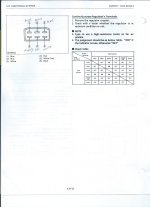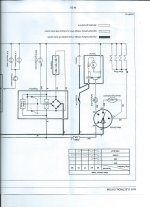The WSM sure didn't give you a lot to go on. I bet fixing the corroded connectors like mentioned above will help you out. If not, thought I would throw a few thoughts out there to help make sense of this WSM regulator test. All testers have a high impedance connection in them, so any would work for your measurement. The reason that they are saying "use a high-resistance tester as far as possible," is that the higher the impedance, the more precise the measurement is. As you may know, a resistor reduces the flow of current through it. If the resistor is large enough, then there will be almost know current though it. This keeps the tester from being damaged by any current if you are testing a "hot" system. If current does flow through it, then the tester could be damaged and the measurement, at the least, will not be accurate.
Oh, impedance and resistance should be used interchangeably here. In DC systems like a tractor/car they mean exactly the same thing. The correct industry lingo used though is impedance whether it's AC or DC, but we can chalk this up to Jinglish. In an AC system like a house, impedance takes into account both the resistance and reactance (kinda like feedback due to inductance and capacitance created from the AC power oscillating back and forth) in the circuit. I will leave it at that because I don't want to derail this.
Also, about the orientation of the + and - probes of the tester, you are right. Normally this has no impact when checking continuity, except if diodes were used. Diodes block the flow of current in one direction until you apply so much power that they break down and then current flows across in a direction that it was not meant to. During a continuity test, the tester will output a small charge to check the continuity. It's only going to flow in one direction, so the orientation in the WSM is to make sure that you are lined up correctly with the direction of the diodes. Hope this helps make sense of the WSM a little bit more.


